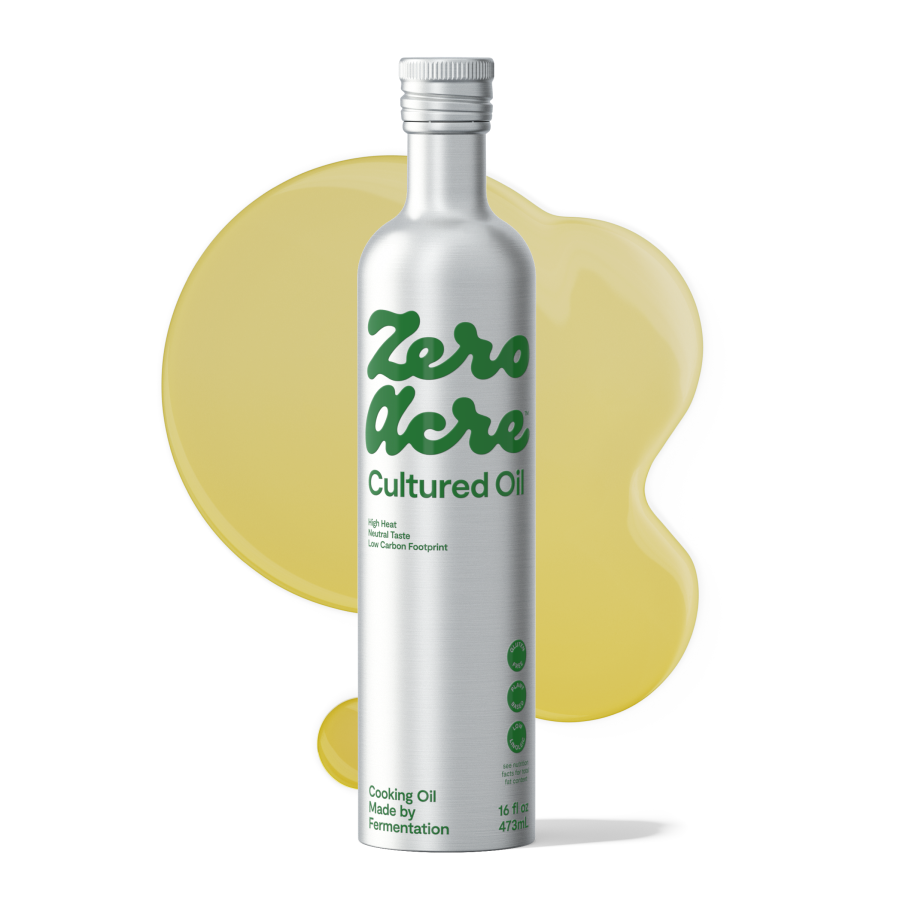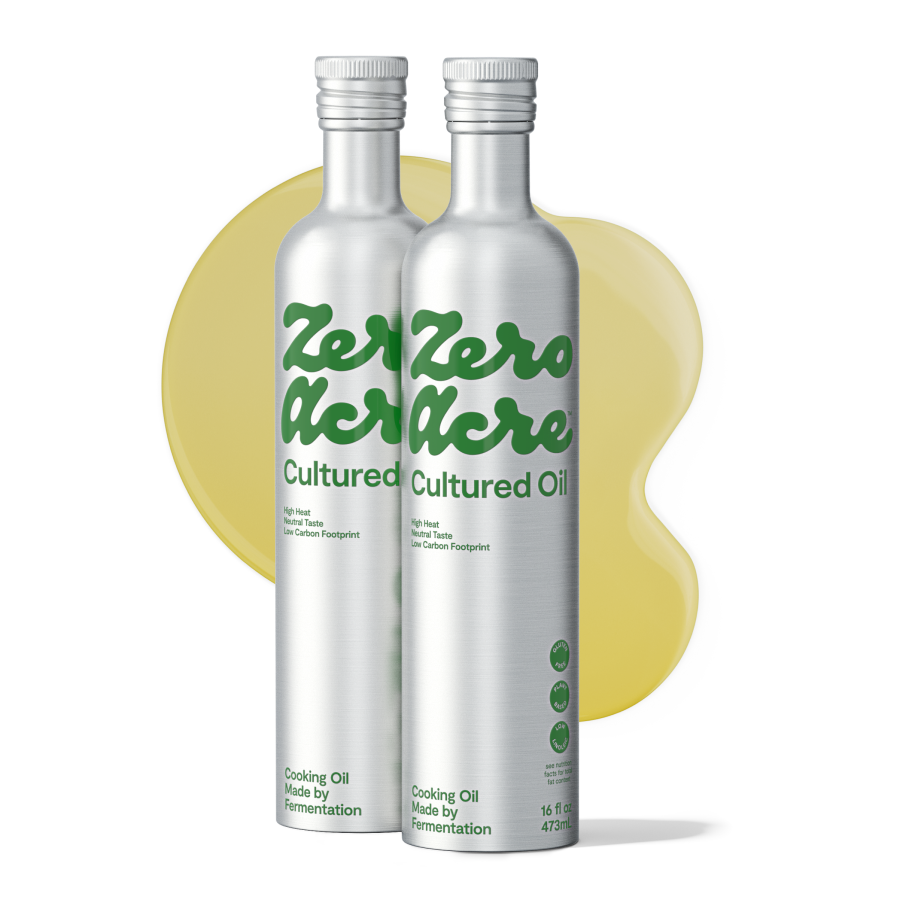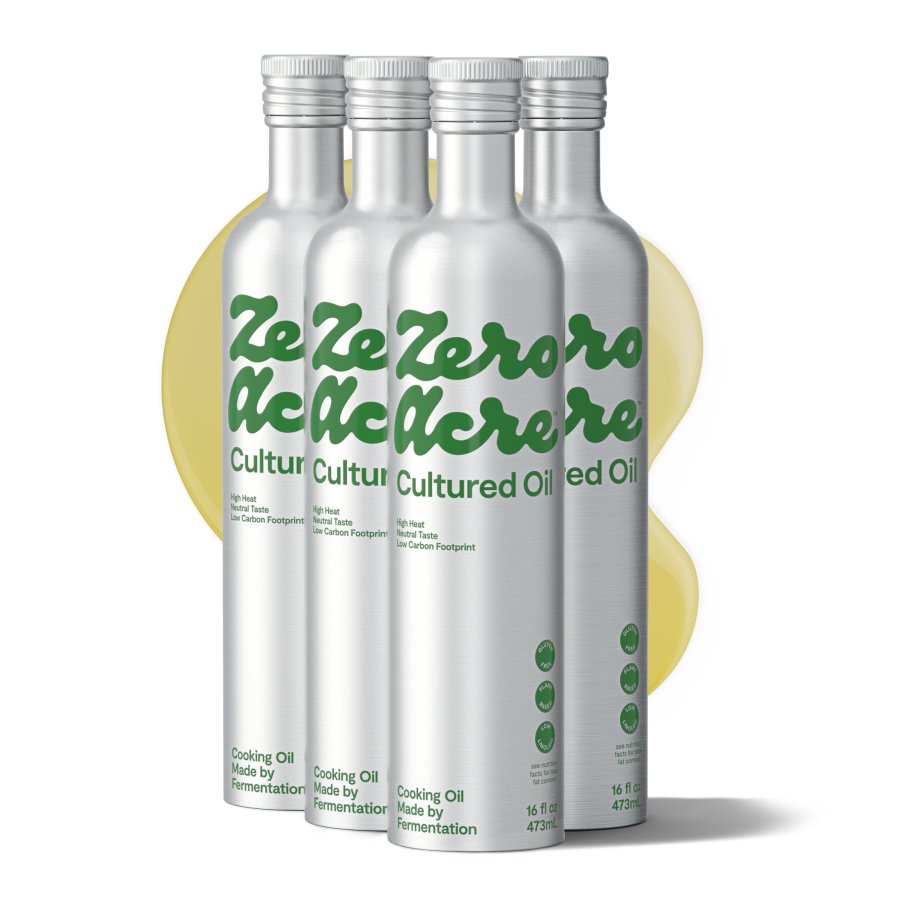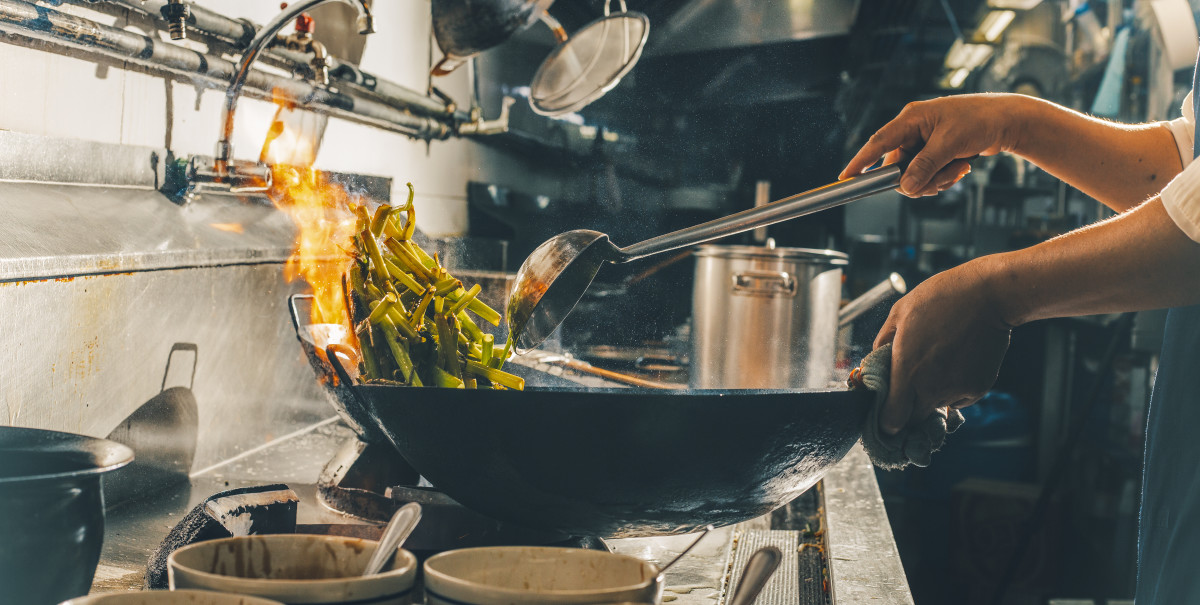WRITTEN BY: The Zero Acre Editorial Team
Article at a Glance
Zero Acre oil is made by fermentation, which means it leaves a much smaller environmental footprint than any other cooking oil.
Zero Acre oil contains over 90% monounsaturated fats and less than 4% polyunsaturated fats, with the lowest level of inflammatory omega-6 linoleic acid (less than 3%) of any liquid cooking oil.
Zero Acre oil has a sky-high smoke point of 485ºF, making it an option for high-heat stir-frying and deep frying.
Zero Acre oil remains liquid when refrigerated, which makes it ultra versatile.
Zero Acre oil can even be used to replace melted butter and vegetable oils in baking.
With a neutral aromatic profile, Zero Acre oil is ready to take on any flavor — from sweet, to savory, to spicy — without overwhelming your dish.
Introduction
Zero Acre oil has officially entered the culinary scene — an all-purpose cooking oil made using the ancient art of fermentation — as opposed to pressing or chemically extracting oil from seeds and grains. Fermented oil may be new to your kitchen, but the fats it contains are the same ones you’ve been using your whole life (mostly monounsaturated fats — just like olive oil).
Still, you may be wondering how best to use it. With more versatility than any existing cooking fat, Zero Acre oil will easily become your go-to for everything from whipping up a salad dressing, to making brownies or frying up some homemade french fries.
Zero Acre oil can withstand high heat cooking without oxidizing as easily or introducing any off or rancid flavors. It remains liquid at room and refrigeration temperatures, and has a clean, neutral taste that easily takes on the flavor of whatever you’re cooking with. But before we get into how exactly you use Zero Acre oil, what exactly is it?
What is Zero Acre oil?
Zero Acre oil is an all-purpose cooking oil made by fermentation — one of the oldest forms of culinary technology. Full of heart-healthy and heat-stable monounsaturated fat, Zero Acre oil is the perfect replacement for destructive, inflammatory seed oils.
And because it doesn’t rely on monocrop agricultural production, it promises to save millions of acres of land, fresh water, CO2 emissions and biodiversity if you swap it for comparably unsustainable cooking oils [*,*].
Not only is Zero Acre oil better for the future of the planet, it’s bursting with even more healthy monounsaturated fats than olive oil and has one of the lowest levels of linoleic acid of all currently available liquid cooking oils [*].
Zero Acre oil Benefits
Zero Acre oil is a liquid oil with an ultra-low concentration of inflammatory omega-6 fat, linoleic-acid — under 3%.
Zero Acre oil is high in monounsaturated fats, boasting even more than olive oil and avocado oil.
Because it’s high in monounsaturated fats, Zero Acre oil is more stable when exposed to heat than other vegetable and seed oils with higher polyunsaturated fat concentrations.
Zero Acre oil has one of the highest smoke points of all cooking oils available at 485ºF — only refined avocado oil has a comparably high smoke point.
Zero Acre oil has a clean, neutral taste, so it’s extremely versatile and can be used for just about anything.

8 Flavorful Ways to Use Zero Acre oil
Salad Dressings
Chef and food writer Samin Nosrat famously illustrated the essential components of a balanced salad dressing in her seminal cookbook, and later Netflix series, Salt, Fat, Acid, Heat.
She writes, “The most important thing about any dressing is to strike a proper balance of salt, fat and acid.” Along with your favorite savory seasonings and citrus or vinegar of choice, Zero Acre oil is here to take your homemade salad dressing to a new level.
Not only does oil in dressing contribute to a salad’s satisfying mouthfeel, it enhances your body’s ability to absorb the fat soluble vitamins and minerals (vitamins K, E, D, and A and various minerals like zinc and copper) that are already abundant in your colorful bowl [*].
Because of their high freezing points (the temperature where liquid turns to solid), salad dressings made with olive or avocado oil harden when stored in the refrigerator, making them difficult to use if you make a large batch in advance. Zero Acre oil's uniquely low freezing point allows home cooks and restaurant chefs to make, store, and use homemade dressing without any added frustration.
Make it: Samin Nosrat’s “Best Vinaigrette”
Adapted from: Sue Moran ℅ Samin Nosrat [*]
Yield: 1 cup
Ingredients
1 shallot, peeled and minced finely
2 Tablespoons plus 1 teaspoon sherry vinegar
1 Tablespoon warm water
1 cup Zero Acre oil
1-½ teaspoons Dijon mustard
1-½ teaspoons grainy mustard
2 teaspoons honey
1 teaspoon fresh thyme leaves
1 clove garlic, grated
Coarse salt and fresh ground black pepper
Directions:
Rince the minced shallot under cold water in a fine mesh strainer. Let drain, and then put the shallot into a mason jar or small bowl. Add vinegar and warm water, and let sit for a few minutes to let the flavor mellow. Whisk in the oil, mustards, honey, thyme, garlic, salt and pepper. Taste the dressing and adjust to your liking.
Homemade Mayo
Most store-bought mayonnaise is made primarily with high linoleic acid seed oils like canola or soybean oils because of their neutral flavor profiles. While a tablespoon here and there might not seem like a big deal, too much omega-6 linoleic acid over time can add up in your body, contributing to issues like obesity, heart disease, and blood sugar imbalance.
Luckily, you can easily whip up a fresh batch of mayo or aioli at home with Zero Acre oil. And because of its neutral flavor profile, you won’t get the grassy, “green” flavor that comes with mayos made from olive or avocado oils. Check out the easy recipe below to use in sandwiches, salads, and more.
Make it: Homemade Mayo
Adapted from the New York Times [*]
Yield: 1 cup
Ingredients:
1 large egg yolk, at room temperature
2 teaspoons lemon juice
1 teaspoon Dijon mustard
¼ teaspoon kosher salt
1 teaspoon cold water
¾ cup Zero Acre oil
Directions:
In a medium bowl, whisk the egg yolk, lemon juice, mustard, salt and 1 teaspoon cold water together until frothy. Starting drop by drop, slowly add the oil while whisking constantly. When the mayonnaise is thick and emulsified, you can add the remaining oil in a steady stream.
Marinades
Marinades are as important for flavoring as they are for tenderizing. Marinades are traditionally made with some combination of oil, acid, salt, and aromatics like herbs and spices. The salt and acid help to tenderize the proteins and connective tissue in meat, which is particularly helpful for tough cuts like flank steak or pork shoulder.
Meanwhile, oils help to transfer fat-soluble flavors from the herbs and spices onto the surface of the protein. When herbs like oregano, rosemary, thyme and sage are used, marinades can also help reduce the formation of carcinogenic compounds like heterocyclic amines (HCAs) and polycyclic aromatic hydrocarbons (PAHs), in high heat grilling and broiling [*].
How long you let your food marinate depends on how much tenderizing it needs — fish and vegetarian proteins like tofu need just a few minutes of marinating, while a pork tenderloin can marinate in the fridge for 24 hours.
Zero Acre oil is perfect for marinades because it will remain liquid at room temperature and in the fridge, allowing the marinade to do its job whether that takes 15 minutes or the whole day.
And because Zero Acre oil has over 90% monounsaturated fat, and less than 4% polyunsaturated fat, it is resistant to oxidation and won’t produce harmful byproducts when cooked at high temperatures, as marinated foods often are.
Make it: Herb and Garlic Marinade
Adapted from Martha Stewart Living [*]
Yield: ¾ Cup
Ingredients:
⅓ cup Zero Acre oil
¼ cup freshly squeezed lemon juice
½ cup chopped fresh herbs (mixture of oregano, thyme, parsley, basil, sage, rosemary, etc.)
2 cloves of garlic, coarsely chopped
Salt and freshly ground black pepper
Directions:
Whisk ingredients together in a non-reactive bowl (ceramic, glass or stainless steel). Immerse protein of choice in the marinade and ensure that all surfaces are covered. Place marinated protein along with remaining marinade in a dish or bag with an airtight seal, and refrigerate according to marinating times below prior to cooking.
Marinating times:
Shellfish: 20 minutes
Cheese, tofu, and vegetables: 30 minutes
Thin and flaky fish filets: 30 minutes
Thick and fatty fish filets: 1 hour
Beef, chicken, game, lamb, and pork: 6 to 24 hours

Baking
While Zero Acre oil is not a one-to-one replacement for lard, butter, or tallow, which are animal fats that are solid at room temperature and often used in baking, it still deserves a place in your baking cabinet.
Contrary to what you might believe, oil can be just as much of a workhorse as butter in your baking recipes, and, as featured in the Washington Post, actually leads to baked goods that are more moist, tender, and long-lasting than their butter-based counterparts [*].
Using oil instead of butter leads to more tender cakes, quickbreads, and brownies because the dough is less likely to be overmixed, which contributes to gluten formation — the protein in wheat, rye and barley that gives bread its signature chewy texture. Oil is also 100% fat, whereas butter contains about 20% water that interacts with the gluten protein and increases the chewiness factor of the end product.
You can substitute Zero Acre oil for any baked good recipe that calls for melted butter by using about ¾ of the recommended amount, since butter is only 80% fat. Zero Acre oil is also an easy one-to-one replacement for vegetable oil in recipes that call for it, like brownies.
Make it: “Katherine Hepburn Brownies”
Adapted from Epicurious [*]
Yield: 12 Brownies
Ingredients:
6 tablespoons Zero Acre oil
2 squares unsweetened chocolate
1 cup sugar
2 eggs, room temperature
½ teaspoon vanilla extract
¼ cup all purpose flour
¼ teaspoon salt
1 cup chopped walnuts (optional)
Directions:
Melt chocolate with Zero Acre oil in a saucepan over medium-low heat. Once fully melted, take off the heat and set aside. Add sugar to a medium bowl. Add eggs and vanilla extract to the bowl with the sugar, and beat with an electric mixer or whisk. Add melted chocolate and oil mixture to the bowl. Next, add the flour, salt, and walnuts (if using) and stir until everything is combined. Add the batter to a prepared 8” baking dish and bake at 325°F for about 40 minutes.
Grilling
Aside from campfire cooking, grilling is the closest we get to the traditional method of cooking over an open flame, where the high heat of the grill sears and caramelizes the outer layer of meat, seafood, and vegetables, imparting its signature “char.” In order to grill healthfully, without increasing the formation of harmful oxidative byproducts, you need a cooking oil built to withstand the high temperatures of the flame.
Because Zero Acre oil has a sky-high smoke point of up to 485ºF, and contains up to 10 times less polyunsaturated fats (PUFAs) than olive oil, avocado oil, and canola oil and 20-40 times less than other seed oils, it’s far less likely to break down or oxidize at high temperatures. That means you’ll actually reap the benefits of the oil when you enjoy your dinner from the grill, instead of consuming unwanted toxic aldehydes and burnt byproducts.
Finishing
Finishing a dish with a drizzle of oil provides a photo-worthy shine and mouth watering flavor. Part of the reason fat makes food taste good is that it helps bind flavor compounds to your taste buds and distributes that flavor throughout your mouth when you chew. To liven up the flavor of a bowl of soup, a dish of hummus, or a pile of veggies, drizzle a small amount of oil on top.
If you’re looking to pack even more wow factor, consider flavoring your finishing oil with garlic or toasted spices. Exposing spices to heat and oil unlocks the flavor — this is known as “blooming” — and infuses it into the oil. Experts recommend using an oil with a high smoke point for blooming spices, so Zero Acre oil is a perfect fit.
Make it: Garlic-Infused Zero Acre oil
Yield: ½ Cup
Ingredients:
½ cup Zero Acre oil
4 garlic cloves, peeled
Directions:
In a small saucepan, gently heat oil and garlic together on low. Watch carefully to ensure the garlic cloves do not burn. Simmer gently on low for 30-35 minutes until the garlic is light golden and soft. Remove from the heat and gently smash the garlic cloves with the back of a wooden spoon. Let the smashed garlic and oil infuse together as they cool for another 30 minutes. Strain the garlic from the oil using a fine mesh strainer. Drizzle on everything from hummus to popcorn.
Stir-Frying
Stir-Frying is a traditional Chinese method of cooking that features the use of a Wok, whose unique shape contributes different heat “zones” in the pan that helps to cook food quickly as it is tossed, or stirred, around. Without the Wok, a shallow frying pan will heat to a relatively uniformly high temperature, which is helpful for forming a crust or sear on meat, fish, or vegetables.
Use Zero Acre oil instead of canola, peanut, or vegetable oil when stir-frying to amp up the monounsaturated fat content of your dish while retaining a neutral flavor that won’t compete with whatever sauce you choose to add down the line, and without smoking up your kitchen.
As pointed out earlier, Zero Acre oil is unique in its resistance to oxidation when exposed to heat compared to other cooking oils. In a third party test, Zero Acre oil was the only cooking oil studied to show zero measurable PUFA-derived aldehyde formation after 10 minutes of cooking — the typical amount of time you’re likely to stir-fry [*].
Deep Frying
Equal parts luxurious and nostalgic, deep fried foods are irresistable and impossible to replace. Deep fried foods get a bad rep in the health space, but it turns out they don’t necessarily have to be bad for you.
A lot of the fear of deep fried foods lingers from our cultural fear of fat that spurred out of early cardiovascular research, which has since become a lot more nuanced (sparknotes: the type of fat matters a lot more than the amount of fat, and fat is a crucially important part of a balanced diet!).
While it’s true that research has linked consumption of deep fried foods with increased risk for disease, it’s not simply because deep fried foods are high in fat — it’s because of the type of fat used in the cooking [*].
For one thing, deep fried foods aren’t necessarily higher in fat or calories than pan-fried foods, and the amount of fat absorbed in cooking has a lot to do with the moisture content of the food being cooked — high moisture content leads to high fat absorption both in the pan and in the fryer [*].
What’s more, a telling cohort study in Spain found no association between fried food intake and all-cause mortality. Researchers of the study concluded this likely had to do with the use of high monounsaturated fat oils like olive oil in cooking, suggesting that the health effects of deep fried foods have more to do with the type of oil used than the deep frying itself [*].
Deep frying cooks food at temperatures between 350-375°F. Many industrial and restaurant kitchens reuse oil after heating, repeatedly increasing exposure to oxygen and water which increases the amount of oxidation over time. Vegetable oils that are high in PUFAs are most likely to oxidize, while Zero Acre oil, which contains less than 4% PUFAs, is 3-4 fold more stable and will not produce trans-fatty acids at frying temperatures [*]. So, if you want healthier fried foods — definitely choose Zero Acre oil.
Make it: Homemade Potato Chips
Adapted from Taste of Home [*]
Ingredients:
7 unpeeled medium potatoes (about 2 pounds)
2 quarts ice water
5 teaspoons salt
2 teaspoons garlic powder
1½ teaspoons celery salt
1½ teaspoons pepper
Zero Acre oil for deep frying
Directions:
Using a vegetable peeler or mandolin, cut potatoes into very thin slices. Place slices in a large bowl with ice, water and salt. Soak for 30 minutes. Drain the potatoes and pat dry on towels. In a small bowl, combine the spices and set aside. In a heavy skillet, heat 1-½ inches of oil to 375°F. Fry potatoes in batches until golden brown, 3-4 minutes, stirring frequently. Remove with a slotted spoon and drain oil on paper towels. Immediately sprinkle with seasoning mixture.

The Takeaway
Though Zero Acre oil is new to the scene, it’s here to become a mainstay in the kitchens of home cooks and restaurants alike. The versatility of a high-heat, neutral oil that resists oxidation and remains liquid at refrigeration temperatures just about does it all. You can clean out your pantry to make room for the one oil you’ll be able to use for any purpose, knowing that you’re also leaving a smaller trace on the planet.



